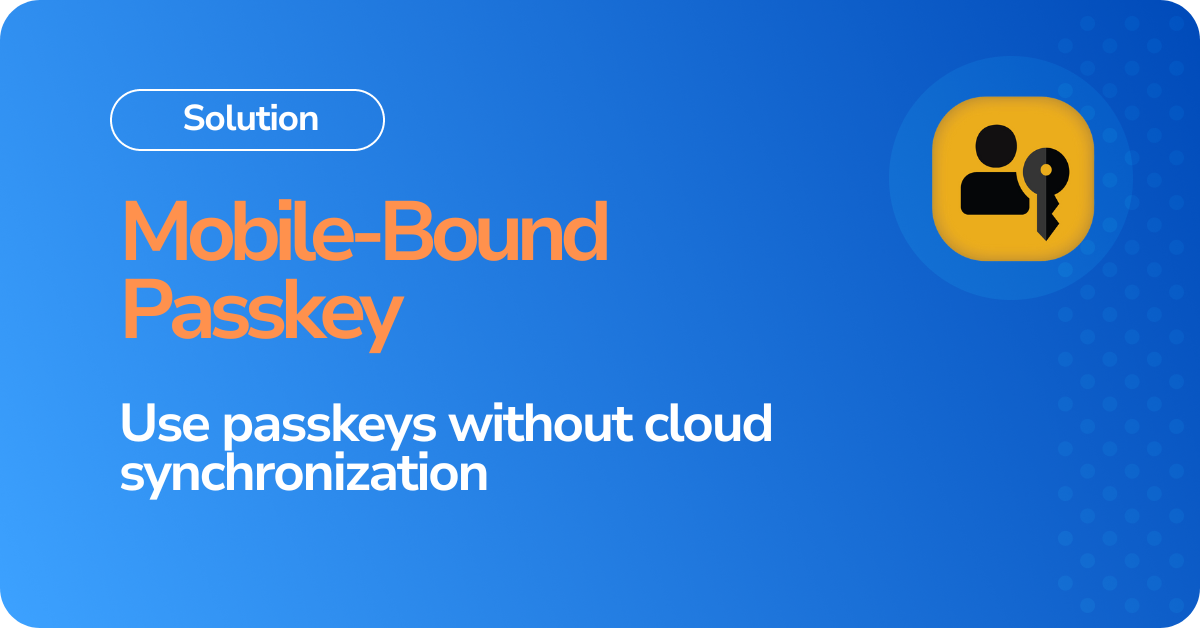Why enterprises need more control over passkeys
Passkeys have significantly improved authentication security, offering phishing-resistant and passwordless logins. They eliminate weak passwords and reduce the risk of credential theft. However, many passkey implementations allow synchronization across multiple devices using cloud storage, which raises security and compliance concerns for enterprises.
Common enterprise challenges with synced passkeys
- Lack of control over authentication keys – Employees may store passkeys on personal devices, increasing the risk of unauthorized access.
- Cloud storage risks – Passkeys synced via cloud services could be vulnerable to breaches or government access requests.
- Regulatory compliance issues – Some regulations (e.g., PSD2, NIS2, DORA) prohibit cloud-based authentication for sensitive systems.
- Device management complexity – IT teams struggle to enforce authentication policies when passkeys can be copied across multiple devices.
To solve these challenges, Mobile-Bound Passkeys provide a secure, enterprise-focused approach to passwordless authentication.
What are Mobile-Bound Passkeys?
A Mobile-Bound Passkey is a cryptographic key that remains exclusively stored on a single, authorized corporate phone. Unlike synchronized passkeys, it cannot be transferred to other devices or stored in the cloud.
This approach ensures that authentication remains tied to a company-managed mobile device, giving IT teams complete control over access while maintaining strong security and regulatory compliance.
How Mobile-Bound Passkeys Work
A user registers a passkey on their corporate phone using a dedicated application.
- The passkey is securely stored in a Secure Element or Trusted Platform Module (TPM), preventing copying or extraction.
- Authentication occurs using the passkey stored on the phone—without passwords or cloud-based sync.
- IT administrators can enforce policies restricting authentication to company-approved devices only.
Key benefits of Mobile-Bound Passkeys for enterprises
1. Prevents passkey synchronization and unauthorized transfers
Unlike cloud-synced passkeys, Mobile-Bound Passkeys ensure that authentication credentials never leave the corporate phone. This prevents:
- Employees from transferring passkeys to personal devices
- Unauthorized access from unmanaged endpoints
- Cloud-based risks, including data breaches and regulatory concerns
2. Strengthens enterprise security
By storing passkeys only on company-managed mobile devices, organizations gain greater control over authentication.
- Eliminates phishing and credential theft
- Prevents man-in-the-middle (MITM) attacks
- Ensures authentication keys are stored in protected hardware (Secure Element or TPM)
3. Ensures compliance with security regulations
Many industries have strict authentication requirements, and some prohibit cloud-based credential storage. Mobile-Bound Passkeys align with:
- PSD2 – Strong Customer Authentication (SCA) compliance for financial institutions
- NIS2 & DORA – Cybersecurity and operational resilience requirements for enterprises
- GDPR – Secure authentication without relying on third-party cloud providers
4. Reduces IT complexity and costs
Managing physical security keys is operationally complex and costly. Mobile-Bound Passkeys eliminate:
- Logistical challenges of distributing and managing hardware keys
- The need for employees to carry external authentication devices
- Helpdesk requests for password resets and lost security keys
5. Seamless user experience without sacrificing security
Users want authentication that is both secure and simple. Mobile-Bound Passkeys offer:
- Passwordless logins with a tap on their corporate phone
- Integration with biometrics (Face ID, fingerprint) for fast authentication
- No need for additional hardware or USB security keys
Where can Mobile-Bound Passkeys be used?
- Financial Institutions – Secure employee authentication for banking and fintech while ensuring PSD2 compliance.
- Healthcare Organizations – Protect access to patient data while meeting HIPAA security requirements.
- Government & Public Sector – Enforce authentication on government-issued devices for classified systems.
- Enterprises & Corporations – Strengthen security policies by preventing passkeys from being stored on personal devices.
How to implement Mobile-Bound Passkeys in your organization
1. Deploy a dedicated authentication app
Mobile-Bound Passkeys require a dedicated mobile application that stores passkeys securely within a Secure Element or TPM. This prevents unauthorized exports or transfers.
2. Integrate with Existing IAM systems
Mobile-Bound Passkeys are compatible with existing authentication standards, including:
- SAML
- OAuth
- OpenID Connect
This means enterprises can implement them without modifying applications.
3. Enforce corporate device policies
IT administrators can configure policies that restrict passkey use to company-issued devices only. This prevents employees from registering passkeys on personal phones or unauthorized endpoints.
Conclusion: Why enterprises should use Mobile-Bound Passkeys
Passkeys have transformed authentication by eliminating passwords and reducing security risks. However, enterprises require greater control over authentication keys to prevent unauthorized access and ensure compliance.
Mobile-Bound Passkeys solve these challenges by binding passkeys exclusively to corporate phones, eliminating synchronization risks while maintaining the security and usability of passwordless authentication.
Key Takeaways:
- No cloud synchronization – passkeys remain on corporate devices
- Prevents employees from transferring credentials to personal phones
- Aligns with compliance regulations (PSD2, NIS2, DORA, GDPR)
- Stronger security without impacting user experience
For organizations looking to strengthen authentication security while maintaining control, Mobile-Bound Passkeys are the ideal enterprise passwordless authentication solution.

Learn how Secfense can help your enterprise implement Mobile-Bound Passkeys. Contact us or watch our download our special report on passkeys.
